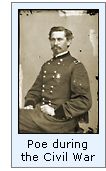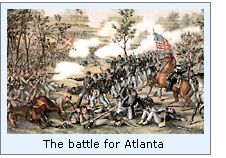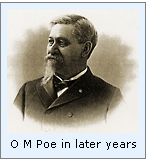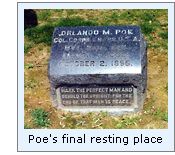Military History
Orlando Metcalfe Poe was born on March 7, 1832, in Navarre, Ohio.
Entered the U.S. Military Academy in 1852, he graduated sixth in his
class in 1856. Poe attained the rank of First
Lieutenant while appointed to the position of assistant topographical
engineer on the survey of the northern Great Lakes from 1856-1861.
 With the outbreak of the Civil War, Poe
assisted in organizing the Ohio volunteers, and later became a member of
General McClellan's staff, in which capacity assisted in organizing the
defenses of Washington D.C. against the Confederate forces. On September 16, 1861, Poe attained the
rank of Colonel, and was placed in charge of the 2nd Michigan
Volunteers. Poe went on to command this regiment successfully during
both the Peninsular and Maryland campaigns, and was commissioned as
Brigadier-General on November 29, 1862. He later served as chief
engineer of the XXIII Army Corps in the capture of Confederate forces
occupying Knoxville, Tennessee. With the outbreak of the Civil War, Poe
assisted in organizing the Ohio volunteers, and later became a member of
General McClellan's staff, in which capacity assisted in organizing the
defenses of Washington D.C. against the Confederate forces. On September 16, 1861, Poe attained the
rank of Colonel, and was placed in charge of the 2nd Michigan
Volunteers. Poe went on to command this regiment successfully during
both the Peninsular and Maryland campaigns, and was commissioned as
Brigadier-General on November 29, 1862. He later served as chief
engineer of the XXIII Army Corps in the capture of Confederate forces
occupying Knoxville, Tennessee.
Poe then assumed the position of Chief
Engineer of the Army of the Ohio, and successfully directing the defense
of Knoxville against Confederate General James Longstreet's forces. Poe's continuing success was not going
unnoticed, and General W.T. Sherman selected Poe as his Chief Engineer
in April of 1864.
 Under Sherman's orders, Poe "thoroughly destroyed Atlanta, save its
mere dwelling-houses and churches." The destruction was by fire
purposely applied to buildings, and permitted to spread, as was
expected, from house to house until the defenseless city was almost
entirely reduced to ashes. No efforts were made to prevent the spread of
the conflagration, and scarcely any structure was designedly spared.
Only about 450 buildings escaped this ruthless burning, among them many
churches, which in those days generally stood apart from other
buildings. The thoroughness of the destruction can be realized, when we
consider that by the census of 1860 Atlanta had a population of 10,000,
which in 1864 had increased to 14,000. More than 4,000 houses, including
dwellings, shops, stores, mills and depots were burned, about
eleven-twelfths of the city. Capt. Daniel Oakey, of the Second
Massachusetts volunteers, reported "Sixty thousand of us witnessed
the destruction of Atlanta, while our post band and that of the
Thirty-third Massachusetts played martial airs and operatic
selections."
Under Sherman's orders, Poe "thoroughly destroyed Atlanta, save its
mere dwelling-houses and churches." The destruction was by fire
purposely applied to buildings, and permitted to spread, as was
expected, from house to house until the defenseless city was almost
entirely reduced to ashes. No efforts were made to prevent the spread of
the conflagration, and scarcely any structure was designedly spared.
Only about 450 buildings escaped this ruthless burning, among them many
churches, which in those days generally stood apart from other
buildings. The thoroughness of the destruction can be realized, when we
consider that by the census of 1860 Atlanta had a population of 10,000,
which in 1864 had increased to 14,000. More than 4,000 houses, including
dwellings, shops, stores, mills and depots were burned, about
eleven-twelfths of the city. Capt. Daniel Oakey, of the Second
Massachusetts volunteers, reported "Sixty thousand of us witnessed
the destruction of Atlanta, while our post band and that of the
Thirty-third Massachusetts played martial airs and operatic
selections."
Sherman honored Poe for "gallant services in the
capture of both Atlanta and Savannah," and for "gallant and
meritorious service in the campaign ending with the surrender of
Confederate General Joseph E. Johnston."
After the War
With the end of the Civil War, Poe
assumed the position of Engineer Secretary of the Lighthouse Board in
1865, in which capacity he was charged with the supervision of building
projects. In 1870, he was promoted to Chief Engineer of the Upper Great
Lakes Lighthouse District.
 In this capacity, Poe was responsible
for all lighthouse construction, and he was largely responsible for the
design of a style of lighthouse tower that has become known as the
"Poe style" tower. These towers are all tall brick
structures, with a gentle taper from bottom to top. All of the Poe
designed feature graceful embellishments in the form of masonry gallery
support corbels and arch topped windows. Exemplified by the towers at
Grosse Pointe and Presque Isle, all together Poe was responsible for the
construction of a number of such towers throughout Lakes Superior,
Michigan and Huron. In this capacity, Poe was responsible
for all lighthouse construction, and he was largely responsible for the
design of a style of lighthouse tower that has become known as the
"Poe style" tower. These towers are all tall brick
structures, with a gentle taper from bottom to top. All of the Poe
designed feature graceful embellishments in the form of masonry gallery
support corbels and arch topped windows. Exemplified by the towers at
Grosse Pointe and Presque Isle, all together Poe was responsible for the
construction of a number of such towers throughout Lakes Superior,
Michigan and Huron.
 In 1883, Poe became Superintending
Engineer of improvement of rivers and harbors on Lakes Superior and
Huron, where one of his most important projects was the development of
the St. Mary's Falls Canal on the St. Mary's River between Lakes
Superior and Huron. Also during this time, on behalf of General of the
Army, he provided a brief history of the origins of railroad
construction in America to Congress. In 1883, Poe became Superintending
Engineer of improvement of rivers and harbors on Lakes Superior and
Huron, where one of his most important projects was the development of
the St. Mary's Falls Canal on the St. Mary's River between Lakes
Superior and Huron. Also during this time, on behalf of General of the
Army, he provided a brief history of the origins of railroad
construction in America to Congress.
Poe was also responsible for
significant improvements made to the Detroit River and the ship channels
in Chicago, Duluth, and Buffalo.
Many consider Poe's crowning
achievement to be the engineering, design and supervision of a new lock
to at Sault St. Marie during the 1890's. This project was instrumental
in the development of commerce on the Great Lakes, permitting large ore
carrying vessels from mining regions bordering Lake Superior to access
the lower Great Lakes and Atlantic seaboard. At a length of eight
hundred feet, and with a width of 100 feet wide, the new lock was the
largest in the world, and in honor of the designer was named "Poe
Lock," a name that it carries to this day.
Orlando Metcalfe Poe died in Detroit on
Oct. 2, 1895 and is buried in Arlington National Cemetery.
Epilogue
 There is an interesting side story
concerning one of Poe's aides during his time commanding the 2nd
Michigan Volunteers. There is an interesting side story
concerning one of Poe's aides during his time commanding the 2nd
Michigan Volunteers.
Sarah Edmonson was born in 1841 in New
Brunswick, and as an itinerant bible-seller made her way to Flint
Michigan. Assuming a male identity under the name Frank Thompson, she
volunteered in Company F, 2nd Michigan Battalion under Colonel Poe. Her deception must have been wholly
effective, as she took part in the Battles of Blackburn's Ford, Bull Run
and the Peninsula campaign. In 1862, she was made an aide to
Colonel Poe, and in this position undertook at least two intelligence
missions behind Confederate lines "disguised as a woman." She accompanied the 2nd Michigan to
Kentucky in 1863, and for as yet undetermined reasons, deserted soon
after.

Reference Sources

Annual Report of Great Lakes Carriers Assoc. History of the Iron
Trade, 1910
Email from Janet Greentree, 05/30/2000
Library of Congress, OM Poe records
The Confederate States of America, Sherman In Georgia, website
Union General Officers website.
2nd Michigan Volunteer Infantry, Sarah Edmonson, website
|
 With the outbreak of the Civil War, Poe
assisted in organizing the Ohio volunteers, and later became a member of
General McClellan's staff, in which capacity assisted in organizing the
defenses of Washington D.C. against the Confederate forces. On September 16, 1861, Poe attained the
rank of Colonel, and was placed in charge of the 2nd Michigan
Volunteers. Poe went on to command this regiment successfully during
both the Peninsular and Maryland campaigns, and was commissioned as
Brigadier-General on November 29, 1862. He later served as chief
engineer of the XXIII
With the outbreak of the Civil War, Poe
assisted in organizing the Ohio volunteers, and later became a member of
General McClellan's staff, in which capacity assisted in organizing the
defenses of Washington D.C. against the Confederate forces. On September 16, 1861, Poe attained the
rank of Colonel, and was placed in charge of the 2nd Michigan
Volunteers. Poe went on to command this regiment successfully during
both the Peninsular and Maryland campaigns, and was commissioned as
Brigadier-General on November 29, 1862. He later served as chief
engineer of the XXIII  Under Sherman's orders, Poe "thoroughly destroyed Atlanta, save its
mere dwelling-houses and churches." The destruction was by fire
purposely applied to buildings, and permitted to spread, as was
expected, from house to house until the defenseless city was almost
entirely reduced to ashes. No efforts were made to prevent the spread of
the conflagration, and scarcely any structure was designedly spared.
Only about 450 buildings escaped this ruthless burning, among them many
churches, which in those days generally stood apart from other
buildings. The thoroughness of the destruction can be realized, when we
consider that by the census of 1860 Atlanta had a population of 10,000,
which in 1864 had increased to 14,000. More than 4,000 houses, including
dwellings, shops, stores, mills and depots were burned, about
eleven-twelfths of the city. Capt. Daniel Oakey, of the Second
Massachusetts volunteers, reported "Sixty thousand of us witnessed
the destruction of Atlanta, while our post band and that of the
Thirty-third Massachusetts played martial airs and operatic
selections."
Under Sherman's orders, Poe "thoroughly destroyed Atlanta, save its
mere dwelling-houses and churches." The destruction was by fire
purposely applied to buildings, and permitted to spread, as was
expected, from house to house until the defenseless city was almost
entirely reduced to ashes. No efforts were made to prevent the spread of
the conflagration, and scarcely any structure was designedly spared.
Only about 450 buildings escaped this ruthless burning, among them many
churches, which in those days generally stood apart from other
buildings. The thoroughness of the destruction can be realized, when we
consider that by the census of 1860 Atlanta had a population of 10,000,
which in 1864 had increased to 14,000. More than 4,000 houses, including
dwellings, shops, stores, mills and depots were burned, about
eleven-twelfths of the city. Capt. Daniel Oakey, of the Second
Massachusetts volunteers, reported "Sixty thousand of us witnessed
the destruction of Atlanta, while our post band and that of the
Thirty-third Massachusetts played martial airs and operatic
selections." In this capacity, Poe was responsible
for all lighthouse construction, and he was largely responsible for the
design of a style of lighthouse tower that has become known as the
"Poe style" tower. These towers are all tall brick
structures, with a gentle taper from bottom to top. All of the Poe
designed feature graceful embellishments in the form of masonry gallery
support corbels and arch topped windows. Exemplified by the towers at
Grosse Pointe and Presque Isle, all together Poe was responsible for the
construction of a number of such towers throughout Lakes Superior,
Michigan and Huron.
In this capacity, Poe was responsible
for all lighthouse construction, and he was largely responsible for the
design of a style of lighthouse tower that has become known as the
"Poe style" tower. These towers are all tall brick
structures, with a gentle taper from bottom to top. All of the Poe
designed feature graceful embellishments in the form of masonry gallery
support corbels and arch topped windows. Exemplified by the towers at
Grosse Pointe and Presque Isle, all together Poe was responsible for the
construction of a number of such towers throughout Lakes Superior,
Michigan and Huron. In 1883, Poe became Superintending
Engineer of improvement of rivers and harbors on Lakes Superior and
Huron, where one of his most important projects was the development of
the St. Mary's Falls Canal on the St. Mary's River between Lakes
Superior and Huron. Also during this time, on behalf of General of the
Army, he provided a brief history of the origins of railroad
construction in America to Congress.
In 1883, Poe became Superintending
Engineer of improvement of rivers and harbors on Lakes Superior and
Huron, where one of his most important projects was the development of
the St. Mary's Falls Canal on the St. Mary's River between Lakes
Superior and Huron. Also during this time, on behalf of General of the
Army, he provided a brief history of the origins of railroad
construction in America to Congress. There is an interesting side story
concerning one of Poe's aides during his time commanding the 2nd
Michigan Volunteers.
There is an interesting side story
concerning one of Poe's aides during his time commanding the 2nd
Michigan Volunteers.